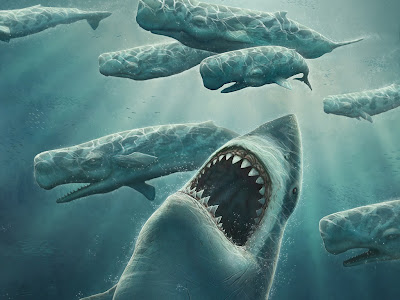Monster of the Deep
I am watching Shark Week on the Discovery Channel. I was seeing a monster shark called Megalodon. This great beast hunt at Capetown, South Africa, Hawaii , Indonesia, Gulf of Mexico etc. Scientists stated the Megalodon is extinct.
What is a Megalodon?:
1. Megalodon's teeth were about 7 inches long...
Megalodon didn't earn its name ("giant tooth") for nothing. The teeth of this prehistoric shark were over half a foot long, serrated, and heart-shaped (by comparison, the biggest teeth of a Great White Shark are only about three inches long). You have to go back 65 million years—to none other than Tyrannosaurus Rex—to find a creature with consistently bigger choppers, though the canines of some saber-toothed cats also measured up.
2. ...and were once described as "tongue stones."
Because sharks are constantly shedding their teeth--thousands and thousands over the course of a lifetime--Megalodon teeth have been found all over the world, from antiquity to modern times. It was only in the 17th century that a court physician named Nicholas Steno identified peasants' prized "tongue stones" as shark teeth; for this reason, some experts describe Steno as the world's first paleontologist!
3. Megalodon had the most powerful bite of any creature that ever lived.
In 2008, a joint research team from Australia and the U.S. used computer simulations to calculate Megalodon's biting power. The results can only be described as terrifying: whereas a modern Great White Shark chomps with about 1.8 tons of force (and a lion with a wimpy 600 pounds or so), Megalodon chowed down on its prey with a force of between 10.8 and 18.2 tons—enough to crush the skull of a prehistoric whale as easily as a grape.
4. Megalodon may have grown to a length of over 60 feet...
Since Megalodon is known from thousands of teeth but only a few scattered bones, its exact size has been a matter of debate. Over the past century, paleontologists have come up with estimates (based mainly on tooth size and analogy with modern Great White Sharks) ranging from 40 to 100 feet, but the consensus today is that adults were 55 to 60 feet long and weighed as much as 100 tons--and some superannuated individuals may have been even bigger.
5. ...which made it much bigger than prehistoric reptiles like Liopleurodon.
The ocean's natural buoyancy allows "top predators" to grow to massive sizes, but none were more massive than Megalodon. The giant aquatic reptiles of the Mesozoic Era, like Liopleurodon and Kronosaurus, "only" attained weights of 30 or 40 tons, and a modern Great White Shark can only aspire to a relatively puny 3 tons. The only marine animal to outclass Megalodon is the blue whale, individuals of which have been known to weigh well over 100 tons.
6. Megalodon lunched on giant whales...
Although the bigger-than-Megalodon blue whale is technically a carnivore, it feeds mostly on tiny krill. Megalodon had a diet more befitting an apex predator, feasting on the prehistoric whales that swam the earth's oceans during the Pliocene and Miocene epochs, but also chowing down on dolphins, squids, fish, and even giant turtles (whose shells, as tough as they were, couldn't hold up against 10 tons of biting force). Megalodon may even have attacked the giant whale Leviathan; see Megalodon vs. Leviathan - Who Wins? for an analysis of this epic battle.
7. Megalodon fossils have been found all over the world.
Unlike some marine predators of prehistoric times--which were restricted to the coastlines or inland rivers and lakes of certain continents--Megalodon had a truly global distribution, terrorizing whales in warm-water oceans all over the world. Apparently, the only thing keeping adult Megalodons from venturing too far toward solid land was their enormous size, which would have beached them as helplessly as 16th-century Spanish galleons.
8. No one knows why Megalodon went extinct.
So Megalodon was huge, relentless, and the apex predator of the Pliocene and Miocene epochs. What went wrong? Well, there's no lack of theories: Megalodon may have been doomed by global cooling (which culminated in the last Ice Age), or by the gradual disappearance of the giant whales that constituted the bulk of its diet. (By the way, some people think Megalodons still lurk in the ocean's depths, as detailed in the Discovery Channel special Megalodon: The Monster Shark Lives, but there's absolutely no reputable evidence to support this.)



Comments
Post a Comment